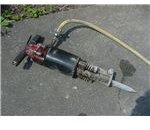- Pneumatics is study of mechanical motion caused by pressurized gases and how this motion can be used to perform engineering tasks. Pneumatics is used mainly in mining and general construction works. Pneumatic devices are used frequently in the dentistry industry across the world. On the other hand, hydraulics means use of pressurized fluids to execute a mechanical task. Hydraulics is frequently used in the concepts of turbines, dams, and rivers. Air brakes in buses, air compressors, compressed air engines, jackhammers, and vacuum pumps are some of the most commonly used types of mechanical equipment that are based on pneumatics technology. Commonly seen hydraulics based equipment types are hydraulic presses, hydraulic hoppers, hydraulic cylinders, and hydraulic rams. In the subsequent sections of this article, you will learn how a pneumatic system works, what its best features are, and its major advantages over hydraulic systems.
Operation of a Pneumatic System
In order to affect mechanical motion, pneumatics employs compression of gases, based on the working principles of fluid dynamics in the concept of pressure. Any equipment employing pneumatics uses an interconnecting set of components: a pneumatic circuit consisting of active components such as gas compressor, transition lines, air tanks, hoses, open atmosphere, and passive components. Compressed air is supplied by the compressor and is transmitted through a series of hoses. Air flows are regulated by valves and the pneumatic cylinder transfers the energy provided by the compressed gas to mechanical energy. Aside from compressed air, inert gases are also applied particularly for self-contained systems. Pneumatics is applied in a wide range in industries, even in mining and dentistry. The majority of industries use gas pressures of about 80 to 100 pounds per square inch.
Over pneumatics, hydraulics is capable of moving heavier loads and having greater force, and since its working fluids are incompressible, it has
minimum spring actions. But at the same time pneumatics are cleaner;
the system uses no return lines and gases are exhausted to the
atmosphere. Thus leaks will be of less concern since the working fluid
of pneumatics is air, unlike oil in hydraulics. Its working fluid is
also widely available and most factories are pre-plumbed for compressed
air distribution, hence pneumatic equipment is easier to set-up. To
control the system, only ON and OFF are used and the system consists
only of standard cylinders and other components, making it simpler than
hydraulics. Pneumatic systems require low maintenance and have long
operating lives. Lastly the working fluid of the pneumatic system
absorbs excessive force, leading to less frequent damage to equipment.
Compressible gases are also easy to store and safer; no fire hazard is
presented and machines could be made to be overload safe.
has
minimum spring actions. But at the same time pneumatics are cleaner;
the system uses no return lines and gases are exhausted to the
atmosphere. Thus leaks will be of less concern since the working fluid
of pneumatics is air, unlike oil in hydraulics. Its working fluid is
also widely available and most factories are pre-plumbed for compressed
air distribution, hence pneumatic equipment is easier to set-up. To
control the system, only ON and OFF are used and the system consists
only of standard cylinders and other components, making it simpler than
hydraulics. Pneumatic systems require low maintenance and have long
operating lives. Lastly the working fluid of the pneumatic system
absorbs excessive force, leading to less frequent damage to equipment.
Compressible gases are also easy to store and safer; no fire hazard is
presented and machines could be made to be overload safe.
Advantages of Pneumatics over Hydraulics
Like hydraulics, pneumatics is a type of fluid power application where instead of an incompressible liquid, pneumatics employ gas in their system. Hydraulics present certain advantages over pneumatics, but in a given application, pneumatic powered equipment is more suitable, particularly in industries where the factory units are plumbed for compressed air.
The air used in pneumatic devices is dried and free from moisture so that it does not create any problem to the internal parts of the system. Moreover, to avoid corrosive actions, oil or lubricants are added so that friction effects can be reduced. Compressed air is used in most of the machines and in some cases compressed carbon dioxide is used. As most of the pneumatic devices are air based, they have a less complicated design and can be made of inexpensive material. Mass production techniques can be adopted to produce pneumatic systems, which not only save money but save time too.
Other major advantages are listed below.
- Initial cost is less; hydraulics equipment cost as much as twice the price of pneumatic equipment.
- A pneumatic water treatment automation system reduces the costs of installation and operation compared with conventional electrical installations. For opening and closing of underwater valves, pneumatic systems work well because they can sustain overload pressure conditions.
- Pneumatic actuators also have long life and perform well with negligible maintenance requirement throughout their life cycle.
- Very suitable for power transmission when distance of transmission is more.
By Tarun Goel
This blog talk about engineers topics, engineering courses and tutorials, engineering jobs: electrical engineering,mechanical engineering,nuclear engineering, petroleum engineering, biomedical engineering, biological engineering,aerospace engineering, industrial engineering, drilling engineering, offshore engineering, reservoir engineering.
adsense
Thursday, July 26, 2012
Advantages of Pneumatics over Hydraulics
Subscribe to:
Post Comments (Atom)
Thanks for sharing with us. Technic Automation is in to business of Industrial Automation. Company is the leading Designer and manufacturer of CUSTOM BUILT AUTOMATION SYSTEM. It is based on Pneumatic Automation (Low Cost Automation), Hydraulic Automation, Air / Hydro Test System, Electric / Electronic / Instrumentation and Marketing Pneumatic Products Pneumatic automation system
ReplyDelete